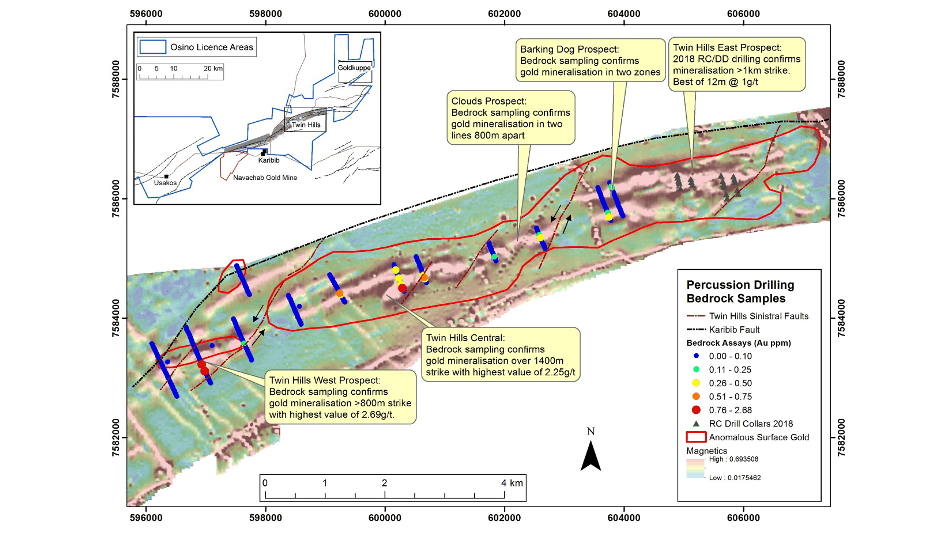Oct 4 2019
Osino Resources Corp. has reported the release of additional bedrock sampling assays for targets within the Twin Hills Gold Project in Namibia.
 Bedrock Gold Assays for Twin Hills Cluster Prospects. (Image credit: Osino Resources Corp.)
Bedrock Gold Assays for Twin Hills Cluster Prospects. (Image credit: Osino Resources Corp.)
Osino utilizes percussion drilling for bedrock sampling to sample the bedrock beneath the thick calcrete and sand cover that is widespread at the Twin Hills Project.
The Project currently includes five surface and bedrock gold prospects, all of which lie along the regional scale Karibib Fault. In 2017, the first anomalies were discovered by Osino and the Project has grown considerably since then. At present, Twin Hills has been split into three sectors, that is, Twin Hills Central, East, and West, with verified bedrock gold discoveries in each sector.
The positive bedrock gold results at Twin Hills West, Barking Dog, and Clouds prospects mean that we now have 11 km strike length of confirmed gold mineralisation in 5 prospects at the Twin Hills Cluster. These gold results, coupled with supporting evidence using arsenic as a pathfinder, give us confidence in the potential of these new prospects to yield further discoveries.
Heye Daun, CEO, Osino Resources Corp.
Heye Daun continued, “We look forward to turning this vision into reality by drill testing these new prospects with the upcoming Phase 2 drill program which will be announced shortly.”
Shallow Percussion Drilling for Bedrock Samples at Twin Hills West, Barking Dog, and Clouds
In total, 117 holes of shallow percussion drilling for 2490 m were finished on August 19th, 2019, on the Twin Hills West, Barking Dog, and Clouds targets, through a layer of calcrete and sand cover of up to 20 m in thickness. These targets were all established by calcrete sampling and ground magnetics, which allowed Osino to probe through the calcrete cover.
The first portion of the bedrock drill program (142 holes for 4662 m) was reported on July 25th, 2019. All bedrock samples were extracted by drilling vertical holes at 25 m spacing through the calcrete cover and sampling the top of the bedrock beneath.
Assay results from this program establish gold mineralization in bedrock at Twin Hills West, Barking Dog, and Clouds, thus incorporating three drill-ready gold prospects along the 11-km Twin Hills Cluster.
Assays obtained for bedrock sampling at Twin Hills West have expanded the zone of mineralization to over 800 m strike length including the highest-grade bedrock sample obtained from the Twin Hills gold system thus far (2.69 g/ton Au).
To the south of the Twin Hills West magnetic zone, a noticeable arsenic anomaly specifies additional size and grade potential. Twin Hills West has currently become a sizable gold/arsenic anomaly with noteworthy potential and signifies Osino’s second priority on the Twin Hills Cluster, after Twin Hills Central. Twin Hills West is located about 2 km to the west of Twin Hills Central and will be drill-tested with diamond drilling and RC in Q4, 2019.
Assays obtained for bedrock sampling at Barking Dog and Clouds prospects also affirm new zones of gold mineralization and signify the 4th and 5th bedrock gold prospects in the Twin Hills Cluster.
The Clouds prospect contains verified gold mineralization in two drill lines 800 m apart and is situated 2 km along strike to the east of Twin Hills Central.
The Barking Dog prospect contains two individual zones of verified gold mineralization in two drill lines 200 m apart. Barking Dog is situated about 4 km along strike to the east of Twin Hills Central.
Implications of Arsenic Anomalies
The gold mineralization intersected presently at Twin Hills is related to arsenopyrite, which verifies that arsenic (As) can be utilized as a path finder element.
All bedrock gold prospects discovered thus far are made larger and more coherent by using the arsenic (As) assay values as an extra indicator.
Arsenic is of specific value as an indicator of gold in this setting for the following reasons:
- Bedrock sampling is the same as collecting a blind rock chip sample every 25 m, meaning that the probabilities of collecting a gold-bearing veinlet are quite low. Arsenic repeatedly occurs as fine-grained disseminated mineralization in altered zones around the gold-bearing veinlets—meaning that the probabilities of sampling anomalous arsenic are higher than sampling anomalous gold.
- In places where the gold mineralization is buried and does not subcrop (against the bottom of the calcrete), there may not be any gold anomaly present at the top of the bedrock. But arsenic is more mobile than gold in several situations, and may form anomalous haloes around buried mineralization by leaking up shears and faults.
- Gold mineralization at Twin Hills is related to three identified iron sulfides, that is, pyrrhotite, pyrite, and arsenopyrite, of which only pyrrhotite is magnetic.
- The magnetic anomaly at Twin Hills is associated with the presence of pyrrhotite but not all pyrrhotite mineralization is related to moderate to high-grade gold. There are hints that the higher-grade gold at Twin Hills is related to arsenopyrite. Arsenic may thus be used to rank higher grade zones and establish mineralization not associated with magnetic anomalies.
- It is noteworthy that the bedrock assays around hole OKD004 (65 m at 1.37 g/ton including 31 m at 2.2 g/ton Au) also exhibit a noticeable arsenic anomaly.